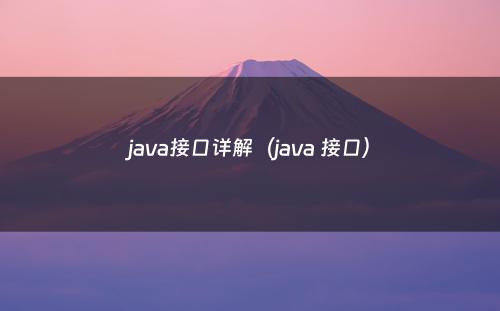/**
* 测试接口 interface

*/
public interface Sheeny {
//接口用interface 不再是class
int LUMINANCE = 2000;
//接口只能定义常量和方法 默认修饰 public static final int
void shine();
//和抽象类一样不写方法体 默认public abstract修饰 子类必须实现
}
interface Long{
void pl();
default void def(){
System.out.println("接口还可以定义默认方法,接口的默认方法必须用default修饰");
System.out.println("默认方法必须要有方法体实现,子类不必须重写实现,可直接调用");
}
}
class Mouse implements Sheeny{
//定义类 实现implements 接口 不再是继承extends
//Mouse为Sheeny接口的实现类
@Override
public void shine() {
System.out.println("mouse.shine");
}
}
class Wand implements Long{
@Override
public void pl() {
System.out.println("Wand.pl");
}
}
class LaserSword implements Sheeny,Long{
//一个类可以实现多个接口
@Override
public void shine() {
//实现的抽象方法也同样要求public
System.out.println("LaserSword.shine");
}
@Override
public void pl() {
System.out.println("LaserSword.pl");
}
int a = LUMINANCE;
//常量直接调用
}
class Test{
public static void main(String[] args) {
Mouse m1 = new Mouse();
int a = m1.LUMINANCE;
//和继承一样 Mouse实现Sheeny接口后可以通过对象m1.调用LUMINANCE常量
Sheeny l1 = new LaserSword();
//和继承中的 父类引用指向子类地址 相同 接口可以声明引用变量类型 不能new创建实例
a += l1.LUMINANCE;
//l1.pl()报错 编译类型无法使用执行时类型的方法
Wand w1 = new Wand();
w1.def();
//Wand类可以直接调用接口的默认方法 也可以重写
}
}
interface P1{
static void printP1(){
//接口中可以定义静态方法 默认修饰 public static
System.out.println("P1.instance initializer");
}
}
class P2 implements P1{
{
/*
printP1()报错,接口的静态方法只能通过接口调用
实现类无法直接调用 这和继承不同
继承中子类可以在类内直接调用父类的静态方法
*/
}
}
class P3{
public static void main(String[] args) {
P1.printP1();
/*
P2.printP1()报错,接口的静态方法不属于实现类
无法通过实现类调用接口的静态方法 这和继承不同
继承中子类继承了父类的静态方法 通过P1.printP1()或者P2.printP1()都可以调用该方法
*/
}
}
class P4 implements P1{
static void printP1(){
System.out.println("实现类可以定义同名静态方法,但不属于重写");
System.out.println("该静态方法和接口的同名方法是两个相互无关的方法");
}
}
interface A1{
void pa1();
}
interface A2{
void pa2();
}
interface A3 extends A1,A2{
//接口可以多继承 子接口会继承父接口的一切
void pa3();
}
class A4 implements A3{
//实现类需要实现pa3()以及A3继承自A1A2的pa1()pa2()
@Override
public void pa1() {
}
@Override
public void pa2() {
}
@Override
public void pa3() {
}
}

本文暂时没有评论,来添加一个吧(●'◡'●)